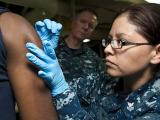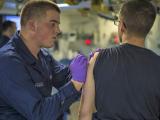Editor's note: This story was revised Feb 11 to include some additional information provided by the Department of Defense.
Feb 8, 2008 (CIDRAP News) – After vaccinating more than a million personnel with the old-fashioned type of smallpox vaccine grown on the skin of calves, the US military is about to switch to a second-generation vaccine that's grown in laboratory cell cultures.
The Department of Defense (DoD) announced last week that it was beginning the change from Dryvax, made by Wyeth, to ACAM2000, which is made by Acambis and was approved by the US Food and Drug Administration (FDA) last August.
Air Force Maj. Gen. Thomas J. Loftus announced the change in a Jan 31 memo. "All Dryvax vials will expire on 29 February 2008 and logistics personnel will be required to destroy all unused vaccine," he wrote. DoD began administering the new vaccine on Feb 1, according to Cynthia Smith, a DoD spokeswoman in Washington.
Since late 2002, DoD has vaccinated more than 1.4 million military and contractor personnel, Smith told CIDRAP News. The shots are mostly for people bound for areas where smallpox attacks are deemed possible—mainly the Middle East. Currently the department gives about 15,000 smallpox vaccinations per month, Smith reported.
Smallpox was eradicated in the 1970s; the vaccination program is predicated on the fear that terrorists could get their hands on smallpox virus stocks left over from the Soviet Union's biological weapons program or from other sources. Known stockpiles of the virus are stored for research in one lab in the United States and one in Russia.
Both ACAM2000 and Dryvax use live vaccinia virus, a close relative of smallpox. The new vaccine is derived from Dryvax, which was used in the global smallpox eradication program. The newer vaccine is grown in lab cultures of African green monkey kidney (Vero) cells, according to a DoD comparison chart.
When the FDA approved ACAM2000 last year, Jesse L. Goodman. MD, MPH, director of the FDA's Center for Biologics Evaluation and Research, said, "The vaccine is manufactured using modern cell culture technology allowing rapid and large-scale production of a vaccine with consistent product quality." Subsequently, Wyeth announced plans to withdraw Dryvax from licensure, according to the DoD memo.
In six clinical studies, ACAM2000 and Dryvax were found to have comparable safety profiles, according to DoD. The most common side effects of ACAM2000 are itching, swollen lymph nodes, sore arm, fever, headache, body aches, mild rash, and fatigue. There was no significant difference in the rate of serious adverse events.
Inflammation of the heart muscle and lining (myopericarditis) occurs in about 1 in 175 first-time smallpox vaccine recipients, according to the FDA. A DoD safety summary says 140 cases had occurred in the military vaccination program as of last May. Smallpox vaccination can also cause several other serious adverse reactions in rare cases, including localized or systemic spread of the vaccinia virus (eczema vaccinatum) and encephalitis.
Smith said DoD will continue its ongoing surveillance for adverse reactions in those who receive smallpox shots. In addition, the FDA is requiring Acambis to take several specific steps to monitor the vaccine's safety, she said. These include:
- Conducting a postmarketing controlled cohort study in a military population
- Conducting an enhanced surveillance program for symptomatic cases of myocarditis and pericardits in vaccinees
- Establishing a myocarditis registry
- Examining how effectively DoD follows its own procedures for identifying people who may be at risk for serious adverse reactions to the vaccine
One difference between the new and old vaccines is in how they are administered. The "scarification" technique used for both vaccines involves multiple pricks with a bifurcated needle. For a first-time vaccination, ACAM2000 requires 15 jabs, versus only three jabs for Dryvax, according to DoD literature. (For those who have been vaccinated before, 15 jabs are recommended with both vaccines.)
Another difference is that ACAM2000 has a shorter shelf life after it is reconstituted by mixing with a special solution—30 days versus 90 days. "Therefore clinics must be diligent in utilization to minimize vaccine loss," says the memo from Loftus.
The ACAM2000 doses will come from the Strategic National Stockpile of medical supplies, according to DoD. When the FDA approved the vaccine, Acambis reported it had already shipped 192.5 million doses to the Department of Health and Human Services for the stockpile.
As a condition of licensing ACAM2000, the FDA said every person getting vaccinated must receive a medication guide developed by Acambis. ACAM2000 is the first vaccine to have such a requirement.
See also:
DoD's ACAM2000 site
http://www.smallpox.mil/education/acam2000.asp
DoD memo about transition to ACAM2000
http://www.smallpox.mil/documents/1133Transition_to_ACAM2000_policy.pdf
Vaccine comparison chart
http://www.smallpox.mil/documents/1126DRYVAX_ACAM2000_comparison.pdf
FDA questions and answers on ACAM2000
http://www.fda.gov/BiologicsBloodVaccines/Vaccines/QuestionsaboutVaccines/ucm078041.htm
Sep 4, 2007, CIDRAP News story "FDA approves Acambis smallpox vaccine"
CIDRAP smallpox overview
http://www.cidrap.umn.edu/cidrap/content/bt/smallpox/biofacts/index.html




















